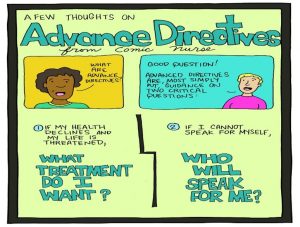
Advance health care directive (AHCD)
An advance health care directive (AHCD) is a legal document that outlines your preferences for medical decisions when you are unable to make those decisions yourself. It serves as a guide for your health care team and loved ones, helping them understand your wishes regarding treatment options and interventions.
AHCD gives you control over medical decisions
An AHCD gives you a voice in your medical treatment even when you are unable to communicate for yourself, and ensures that you have some level of control over your own medical decisions in the case of an accident or emergency, or at the end of life.
With an advance health care directive, you can designate someone to make medical decisions for you in the event that you become unable to do so for yourself. (Prob. §§ 4605, 4629, 4682). You can also name an alternate agent as a backup.
Creating an AHCD is a gift to your family and loved ones. In the event of an emergency they won’t have to guess or worry about making a wrong decision. An AHCD empowers your loved ones to confidently make care decisions on your behalf that they know you would make for yourself.
AHCD involves communicating with family and loved ones
The first step to create an AHCD involves having conversations with your family members or loved ones where you share your wishes for medical care during a medical emergency. You will also identify the person or family member that you trust and who is willing to assume the role of carrying out your wishes in the event of a medical emergency. After that you would complete the legal forms to document your wishes. To be effective, the AHCD must be notarized or witnessed by two qualified individuals.
Give copies of your AHCD to your health care agent, alternate agent, doctor, health plan representatives and family. If you are admitted to a hospital or nursing home, take a copy with you. Consider registering your directive with California’s Secretary of State as well. By doing so, health care providers and other authorized individuals may be able to obtain information from your directive in an emergency if your agents or family members cannot be reached. (Prob. §§ 4800-4806).
AHCD should be reviewed and updated periodically
After age 60 you should take a close look at your AHCD annually or when there is a life changing event such as a divorce, death of a spouse, or decline and adjust it to reflect any changes in your wishes or in your health. You can revoke the AHCD at any time, as long as you are still competent. Revocation can be verbally but it is best to put it in writing. Anytime you change or revoke the AHCD you must provide the individuals and hospitals who have your AHCD with an updated copy of the AHCD or notification that it has been revoked. Until you do so the revisions or revocation will not be effective.
Physician orders for Life Sustaining Treatment (POLST)
You may also consider completing a Physician Orders for Life Sustaining Treatment (POLST) form if you are terminally ill or in frail health. Once completed and signed by your physician, this form allows you to give specific orders during a health emergency, for example, your pain management, cardiopulmonary resuscitation, feeding procedures and other medical interventions. It has the force of a physician’s medical order and remains with the patient wherever he or she receives care. It does not, however, replace the traditional advance directive, which includes other instructions. (Prob. §§ 4780-4785) For more information, talk to your doctor or go to www.coalitionccc.org.
Key differences between a POLST and AHCD
| POLST Form | AHCD | |
| What is it? | Legal Document | Medical Order |
| Who should use it? | All adults | Anyone who is seriously ill or frail |
| Why would I need this? | · To tell others who you want to make medical decisions for you, if you can’t communicate
· Tell others what medical treatments you would want, your values, what you care about. |
· Order providers to give specific treatments during an emergency
· Supports the patient across care settings |
| Who fills it out? | The individual | Health care professional (after discussion with patient) |
| Can emergency responders use it? | No | Yes-it tells them if the patient wants CPR and if the patient wants to go to the hospital |
POLST forms and AHCD are both parts of advance care planning but they are not the same. While an AHCD gives directions from the patient, a POLST form consists of a set of medical orders. POLST is for people who are seriously ill or have advanced frailty. POLST forms must be filled out and signed by health care provider. POLST is a more specific document that translates your wishes into actional instructions for healthcare providers, while AHCD provide a general outline of your healthcare preferences and identifies your trusted agent who will carry out those wishes.
Other Resources:
- The California Medical Association at 800-882-1262 (www.cmanet.org).
- The State Office of the Attorney General’s website (oag.ca.gov).
